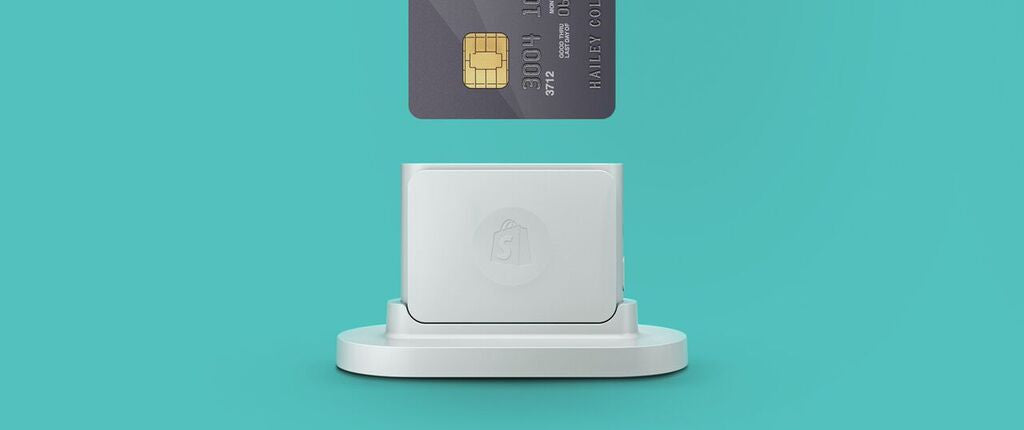In 2016, Shopify’s annual merchant survey revealed that 42 percent of the platform’s 500,000 merchants sell in-person, in some capacity.
Just let that number sink in.
This statistic demonstrates the enormous (and relatively untapped) opportunity for Shopify Partners to start pitching Shopify’s point-of-sale (POS) system to clients.
Shopify POS is a multi-channel platform that gives your clients one system for their online and in-person sales, whether they’re selling in-store, at a market, or for a pop-up shop event. The retail package is included on the Shopify and Advanced Shopify plans, and could be just the solution your clients need.
It can be used for basic in-store features — like processing orders, taking payments (including tap, chip, and swiping credit cards), and producing receipts — or for the more cutting-edge features needed in today’s retail landscape — like analyzing the success of day-to-day sales, tracking and measuring important business metrics, and controlling inventory.
Traditional retailers often struggle to move away from their outdated, overly complicated, or manual solutions. But freelancers and agencies can help merchants make the switch to a more intuitive POS system .
.
You can empower merchants to sell anytime, anywhere.
Today, we’re delving into the opportunity that Shopify POS provides, how to effectively pitch the product to clients, and how to qualify potential leads. In addition, you’ll get first-person advice and insight from Shopify Partners who have successfully built their businesses by providing POS services to their clients.
The retail opportunity
Retail trends show that the divide between online and offline commerce is narrowing, and the future that’s emerging is one where consumers can choose to buy online, in-store, or wherever they happen to find themselves.
If you look around the Shopify ecosystem alone, you can see that future quickly approaching with new opportunities everywhere. The release of the Shopify-designed Chip & Swipe Reader, the announcement of Shopify’s new design system Polaris, and the newly-offered ability to build apps using Shopify’s POS App SDK, all enable new and exciting ways for merchants and Shopify Partners to work with Shopify POS.
Need more proof? Ask the experts.
For Shopify Experts Camila Machado and Bryce Kavanagh — Directors at Gorilla Labs and Shopify POS hardware resellers — POS is a daily conversation with the majority of their clients who have brick-and-mortar stores.
“As Shopify Experts, we really enjoy working with Shopify POS as it’s easy to set up, user-friendly, and works out-of-the-box without headaches,” Camila explains.
as it’s easy to set up, user-friendly, and works out-of-the-box without headaches,” Camila explains.
Shopify Partner Andrew Langlois — President of agency BIZHELM — was working in the POS space before his team started offering clients web development services. He calls POS the heartbeat of the brick-and-mortar business.
He calls POS the heartbeat of the brick-and-mortar business.
“Today’s cloud-based platforms are so much more than just POS. We refer to them as an operating system for a small business, connecting everything from customer data, to social media, to business KPIs.”
You might also like: Learn to Build Apps for In-Person Sales Using Shopify's POS App SDK.
How to pitch Shopify POS

Beyond understanding the technical features and capabilities of Shopify’s POS system, it’s important to understand how to turn that list of features into a clear and effective pitch. Below, our Shopify Experts have outlined a few things to consider when talking to clients about why they should consider POS.
Educate yourself
Similar to the way you’d reseach a client before a major redesign, understanding a POS client’s business from an operational and future goal standpoint is key. Ask a lot of questions, delve into their current processes, discuss the hurdles they face now, and find out the future they want for their business.
As Shopify Plus Partner Andrew Johnson of Rehash explains, the answers to these questions uncover a lot of important information needed to make the right pitch.
“The truth is, there are so many point-of-sale systems out there, and none are one-size-fits-all. Our job as consultants is to point clients to what we believe is the best choice for their business,” he says.
The trick is that you can only pitch the best choice if you fully understand your client’s challenges and needs .
.
Bryce at Gorilla Labs explains that the conversation should be less about pitching, and more about solving some of the pain points in your client’s business.
The conversation should be less about pitching, and more about solving some of the pain points in your client’s business.
“Spend time understanding your client's requirements and how an integrated POS system could benefit them,” Bryce explains. “In addition, based on their requirements, identify any of the limitations that the system may have that could impact your client’s day-to-day operations, like bookings, selling by weight, and so on.”
Educate your client
Educating business owners on the benefits of an integrated system, like Shopify POS, should be a big part of your initial conversations. To start, you can teach them about the importance of having an offline strategy.
For merchants who sell both online with Shopify and in-person with Shopify POS, the average price of an in-person sale is 60 percent larger than an online sale, according to Shopify data. It’s a compelling statistic that demonstrates why Shopify merchants should consider an in-person sales strategy, even if it’s just on the weekends at a local market or fair.
For those ready to invest in a POS system, Shopify Plus Partner Phil de la Gueronniere of Genome suggests outlining the two elements a retailer should consider when deciding on a system: the benefit to the store, and the benefit to the customer.
For the store, merchants should pick a system that allows staff to quickly learn the ins and outs; a system that’s cost effective, yet includes enterprise-level features. The benefit to the customer should be a quick and safe checkout process that shows the retailer cares about the in-store experience.
“Once we lay out the features, value, and comparisons to other options, it becomes clear to the client that POS offers tremendous value that is difficult to replicate with other systems,” Phil adds.
A good way to help educate merchants on the value of POS is to consider doing demos , either in-store or via the web. Do a little research on the company so that you can include some specifics from their store. If you’re dealing with a retailer who still uses a traditional cash register, you can quickly demonstrate some of the efficiencies a cloud-based POS system would provide, helping them realize all the possibilities.
, either in-store or via the web. Do a little research on the company so that you can include some specifics from their store. If you’re dealing with a retailer who still uses a traditional cash register, you can quickly demonstrate some of the efficiencies a cloud-based POS system would provide, helping them realize all the possibilities.
You might also like: Post-Launch Services as a Deliverable: The Win-Win Approach.
Show the simplicity and the possibility
For many merchants, inventory and deciding how to manage it between online and offline channels is quite the conundrum. Shopify POS helps simplify this process by allowing merchants to set their inventory once, and have it available across multiple channels. Orders, customers, and inventory are tracked and managed through a single platform, meaning that regardless of where a product was purchased — online, in-person, or at a special event — your client’s multi-channel inventory issues (returns, reporting, stock, etc.) are covered.
“In general, we try to provide the most integrated solutions with the least amount of friction,” Phil explains. “In our experience, the more tools that you can connect that share the same architecture, the more seamless an experience for both the store clerk and customer.”
Phil adds that if a retailer is using Shopify for ecommerce, but uses another in-store system, his team will recommend adding POS in parallel as a way to get the staff to try it out. The appeal of training staff on a single system is a big plus for clients, and once they get a chance to checkout customers, Phil says they often jump to replace their existing platforms.
Andrew from BIZHELM adds that while there are countless other benefits to Shopify POS, inventory management and the integrated solution it provides across sales channels is the key area where a small business can really benefit. At the end of the day, highlighting POS features that can make a merchant’s life easier is sure to get their attention .
.
We focus on helping our clients see how the right combination of systems and platforms can create efficiencies and collateral possibilities that help them compete in today’s rapidly changing world.
“One of our business tag lines is ‘Automate Your Business,’” Andrew explains. “We focus on helping our clients see how the right combination of systems and platforms can create efficiencies and collateral possibilities that help them compete in today’s rapidly changing world.”
Don’t forget the hardware!

Shopify Plus Partner Chad Fisher of BTown Web says when pitching Shopify POS, mentioning the free Chip & Swipe Reader— which comes with a charging and travel base — is a nice hook.
“If a client is even thinking about traveling to events or selling products in person, we make sure to bring up the POS system to explain how they can extend the functionality of their online store, and take it on the road,” he says.
Shopify POS merchant personas
Now that you know what to consider when pitching Shopify POS, let’s talk about who you’re going to pitch to. While it’s easy to reduce prospective POS clients to only one type (existing Shopify merchants who want to add offline sales), there is in fact a wider array of retailers you should be on the lookout for.
To start your search for leads, you need to understand who’s interested in a point-of-sale solution.
To start your search for leads, you need to understand who’s interested in a point-of-sale solution. Here are four basic merchant personas that your business or agency should consider when qualifying potential Shopify POS clients.
1. The pop-up shop master
These brands have a strong online presence and want to extend their brand offline with a low-risk event, but may not necessarily be using Shopify. Educating clients on the value of an offline experience that’s coupled with an online experience, powered entirely by one platform, is a great way to expose them to Shopify. In addition, while smaller brands are taking advantage of the pop-up strategy, mega-brands like Kylie Jenner’s lip-kit line and The Weekend’s apparel brand have found mega-success cultivating the offline experience.
Their perspective — Pop-up shops give merchants a way to connect with their loyal client base in an authentic way. It also helps them envision a full blown brick-and-mortar business, and lets them observe customer reactions to products and quickly solicit feedback.
2. The boutique owner
This is the merchant most likely to adopt Shopify POS. These clients tend to manufacture or craft their own products and goods, and typically operate a single brick-and-mortar location with a small number of staff (one to five maximum).
Their perspective — These retailers often see POS in one of two ways: either they understand the potential of ecommerce and are searching to extend their offline brand with an online store, or they’re already selling online and want on intuitive, all-in-one solution.
3. The casual seller

Casual sellers are individuals who sell their products on the weekend or seasonally at markets, fairs, or special events.
Their perspective — These merchants need cost-effective solutions to get their products to (the literal) market. They want a solution that can support them now, and that has the ability to scale with the growth of their business.
4. The old school retailer
These legacy retailers or large brick-and-mortar shops typically have multiple locations, employ a large number of staff, and are looking to expand their business in fresh ways. They often don’t have a solid online strategy, and need help taking their business to the next phase: multi-channel.
Their perspective — Advanced retailers want to be more agile and mobile, with the ability to show up at events and sell where a new audience exists. These merchants are often keen to try POS for an experimental pop-up shop, or to test out combining multiple locations under one point-of-sale system.
You might also like: The Ultimate Guide to Finding Web Design Clients.
Finding Shopify POS prospects
Now that you know what type of merchants to look out for, let’s dive into where you can find your POS prospects.
Word of mouth
Andrew from Rehash says his company's most effective way of finding new clients is via the merchants they’ve worked with in the past.
“Word of mouth travels fast among local retail stores, since they’re naturally a closer community than online brands,” Andrew explains. “They’re always talking shop, so having a good reputation as a trusted source on these topics is key.”
Another great way to meet potential clients is to attend local events, like farmer’s markets, local business meet ups, and pop-up shop events in your city. Get your name out into the community by being present in it. Meet the businesses you hope to work with, in person.
Thought leadership
Melissa Gonzales — chief pop-up architect at Lionesque Group — says strong search engine optimization efforts by her team is one way she ensures local merchants interested in POS find her. Couple that with her content marketing efforts (like blogging on the Lionesque Group website and pitching external publications and media), and you have a way of attracting warm leads.
The more you can convey thought leadership, the more authentic and powerful your reach becomes.
“The more you can convey thought leadership, the more authentic and powerful your reach becomes,” she says.
Strategic partnerships
Andrew from BIZHELM advises building strategic partnerships with companies or sales organizations who already have a base of small business clients, but who don’t offer the web and POS services that BIZHELM specializes in.
“By combining our expertise with a set of existing relationships, there’s an instant level of trust that allows us to start the conversation in a different spot than if we were walking in cold,” he says.
A word on qualifying leads
In general, when you’re looking to qualify potential clients, you want to consider a few basic factors:
- Budget — Ensure that the solution makes sense for the merchant and you.
- Current system — What are they currently using to record in-store sales?
- Potential needs — What other systems should be integrated with the new POS system? You want to create additional efficiencies and benefits, so consider ecommerce platforms, accounting systems, CRM tools, email marketing platforms, social media tools, etc.
While it’s important to understand the type of clients you want to work with, it’s just as important to know who you want to avoid.
PayPal research shows that in 2017, 71 percent of those who sell in-person today show no desire to go online. It’s best if Shopify Partners avoid these types of leads, as your strong skillset in ecommerce services shouldn’t be downplayed for retailers with zero interest in online.
The reality is that freelancers and agencies will have more success working with merchants who have an interest in, or aspire to be, online at some point in their entrepreneurial journey. Shopify POS in particular is a product that’s meant to compliment ecommerce skills , and partners should lean into their strengths.
, and partners should lean into their strengths.
Melissa puts it succinctly: “Shopify POS is most powerful when both ecommerce and POS run off one solution provider, like Shopify. It's more efficient to see inventory across channels in one place, in addition to analytics on conversion rates, cart size, etc.”
Instead, look to leverage your skillset, and try pitching to brands who want more agility or who are already online and want to get closer to their audience, wherever they are.
At the end of the day, Chad Fisher says it comes down to having a simple conversation about needs.
“The best way to find out if a merchant is a fit for Shopify POS is to ask questions about sales and marketing, and to find out how the merchant is currently selling their product,” he says. “Through that discovery process, there are often opportunities to discuss Shopify POS and to talk about how it could be a great fit for their business.”
The untapped potential of Shopify POS
Regardless of whether you’re an ecommerce consultant, web designer, or developer, it’s critical to consider adding Shopify POS to your service offering. It’s not only a segment of Shopify’s merchant community that’s seeing tremendous growth, but it holds vast potential for the expansion of your own business.
Read more
- Customer Obsession: Driving Client Decisions the Amazon Way
- 4 Conferences You Should Attend
- 5 Social Media Automation Tools to Help you Grow Your Business’ Online Following
- 5 Ways to Help Clients Succeed in the Build A Business Competition
- 5 Things You Should Know About Forming Strategic Partnerships
- Raise Prices at Your Agency with this Step-by-Step Approach
- 11 Design Interview Questions and How to Master Them
- Grow Your Business With This Free Book
- Content Generation: 2 Secret Weapons to Generate Content for Omnichannel Marketing
- Learn from the Shopify Experts Who Won Build A Business
How do you pitch Shopify POS to clients? Tell us in the comments section below.

